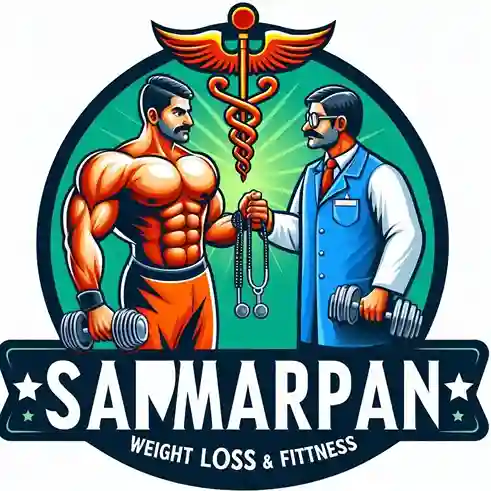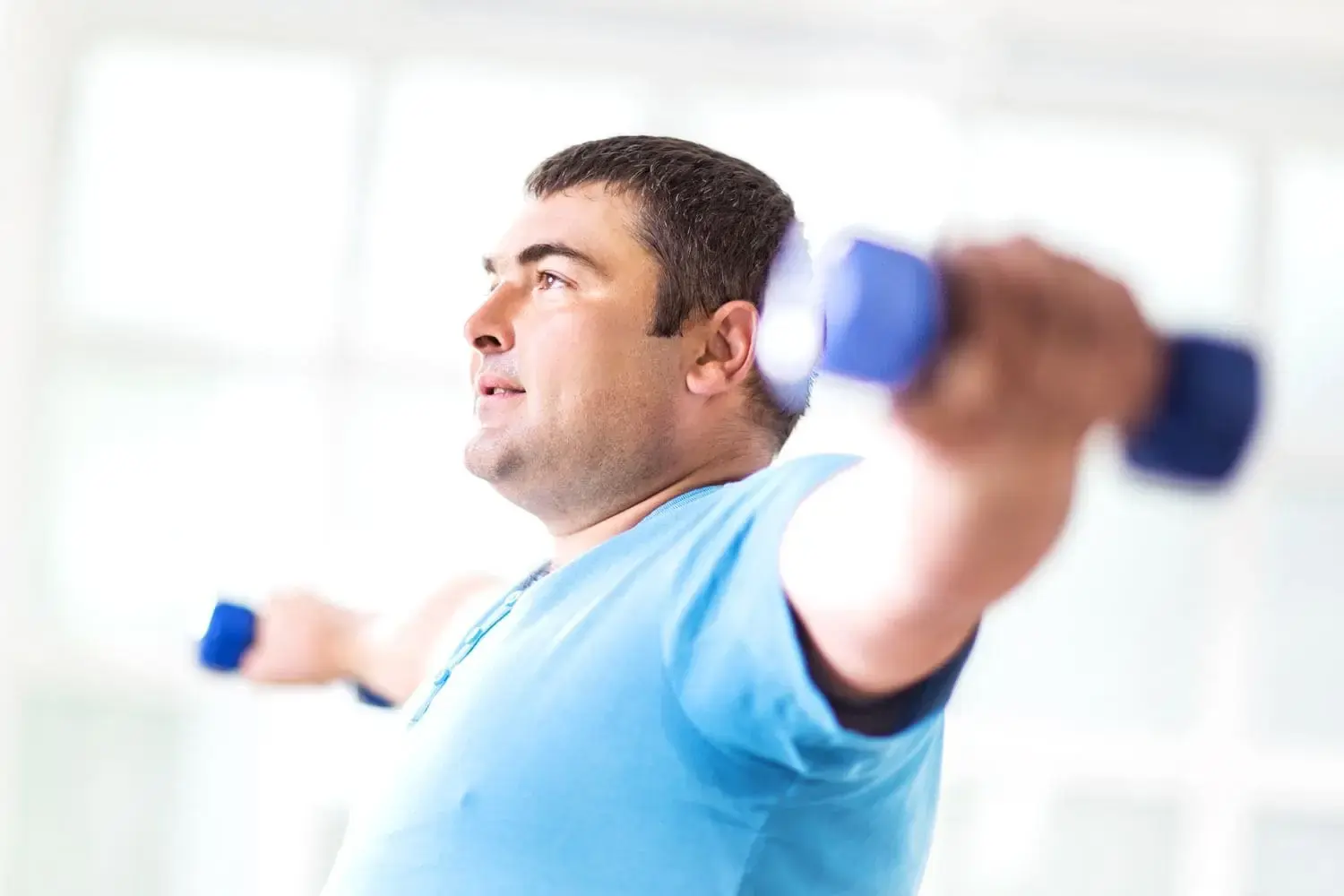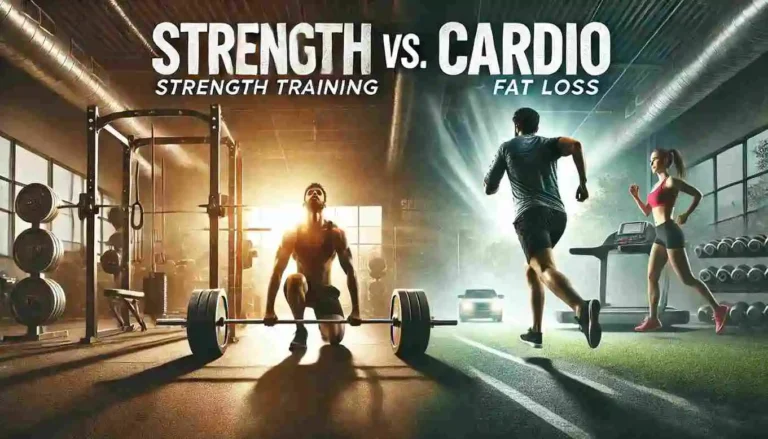16 Best Weight Loss Exercises for Beginners
Introduction:
Weight Loss Exercises for Beginners are designed to help you ease into physical activity while setting the foundation for a healthier, more active lifestyle.
It’s not necessary to engage in intense, sweating workouts to enjoy the benefits of physical activity. Simple, Weight loss exercises for beginners are the best choices for losing weight. You can do them at home or outside, depending on what is most convenient or preferred.
The goal of beginner exercises is to build long-term health habits and increase self-esteem, especially for those who have struggled to maintain an exercise routine. Beginner-level exercise can help you lose weight and improve your health.
If you have never worked out before, low-intensity activity sessions can help you burn more calories. You may lose weight if you refrain from increasing your calorie intake so you can make up for this physical exercise. If you want to lose weight, combining diet and exercise can be beneficial.
Health Benefits of exercise:
Basic workouts are the foundation of a fitness program for beginners. They can help you in forming routines that result in significant weight loss and long-term weight control.
- Exercise has long-term benefits, such as lowering your risk of disease, but it also has instant benefits, such as improving your mood and brain function.
- Being physically active regularly gives your day fresh energy and energy, turning your everyday existence into an exciting journey.
- More mobility and flexibility. Including mobility and stretching exercises improves flexibility, which lowers your risk of injury and makes daily tasks easier.
Weight loss exercises for beginners:
Walking
- For many beginners, walking can be a useful approach to get active without having to buy equipment or encounter difficulties.
- Additionally, it’s a lower-impact workout, so your joints won’t be as stressed.
- To begin, try to walk three or four times a week for thirty minutes.
- As your fitness improves, you can progressively increase the length of your walks or how often you go.
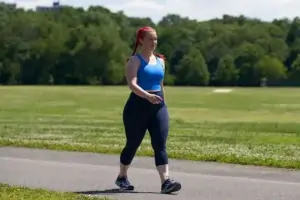
Jump-rope
- With your feet together, stand in the center of the jump rope and extend it up your body’s sides.
- The ends of the rope, excluding the handles, should pass under your armpit.
- With the rope on the floor behind your ankles, grasp the handles in each hand.
- Keep your spine neutral and your core active while stabilizing your shoulders by activating your mid-back.
- Refrain from gazing at the ground and keep your head up.
- Make sure the rope crosses your head by rotating your wrists forward ahead of you.
- To spin the rope, you need to have your elbows flexed and your forearms at waist height.
- Leap one to two inches straight up in the air from the heel of your feet so that the rope clears under you and lands firmly on both feet.
- Aim for each jump with your toes pointed toward the ground.
- Then relax.
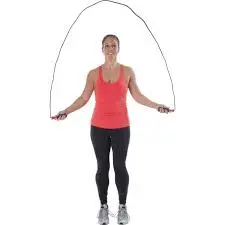
Swimming
- Swimming is an excellent all-around activity and weight-loss workout since it increases heart rate without aggravating ailments because it is low-impact.
- Your entire body gets toned and strengthened as a result.
- Swimming is still a good workout since it incorporates cardio, strength, and flexibility, even though stability in the water helps support your weight and lessens the physical strain on your body.
- Even the simplest freestyle movement works numerous muscles in your upper and lower body, including your quads, pecs, triceps, and shoulders.

Running
- Begin by setting a goal of running for 20 to 30 minutes, three times a week.
- Try running on grass or other softer surfaces if running or jogging outside strains your joints.
- Running requires greater work from the heart, lungs, and muscles and is faster.
- Burning calories in a short amount of time is possible with running.
- Depending on your body size, running speed, and running time, you will burn different amounts of calories.
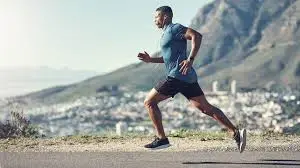
Bodyweight squats
- Place your feet slightly wider than hip-width apart to begin.
- Engage your core muscles and push your hips back while maintaining an even pressure on your feet and an up-and-out chest.
- To begin a squat, lower yourself until your chest begins to stretch forward or round.
- Your form ought to indicate how deep you are.
- To go back to where you started, push through your heels while maintaining a tight core and an outstretched chest.
- At the top, compress your glutes.
- Then relax.
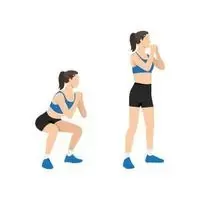
Wall push up
- Place your feet hip-width apart.
- Stay away from the wall by a minimum of an arm’s reach.
- Both hands should be placed on the wall approximately shoulder-width apart.
- Your feet should be closer to the wall if you feel like you’re reaching too far.
- Bend your elbows slowly and start to tilt your body in the direction of the wall until your nose is nearly touching it.
- Your elbows should bend at a 45-degree angle rather than straight to the sides, and your back should remain straight.
- Hold this position for a few seconds.
- Then return to your neutral position
- Then relax.
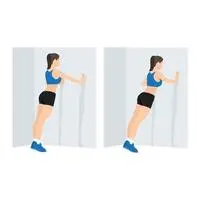
Dumbbell lateral raises
- Standing on the ground is an initial step.
- Then, take two dumbbells in each hand.
- You have the palms of your arms by your sides.
- Place your feet about hip distance apart.
- Check your posture by rolling your shoulders back, activating your core, and gazing straight ahead.
- Raise the dumbbells to either side while maintaining almost straight arms.
- Once you have your elbows at shoulder height and your body in a “T” arrangement, stop.
- Hold this position for a few seconds.
- When you lower the dumbbells, exhale.
- Then relax.
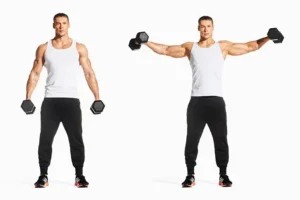
Dumbbell shoulder press
- Start with holding a dumbbell in each hand while sitting with your feet shoulder-width apart.
- Keep the dumbbells at your shoulders while bending your elbows.
- Raise your arms so that the dumbbells are overhead from this starting posture.
- Hold this position for a few seconds.
- Throughout the exercise, make sure your back remains straight and your core remains active.
- Take the dumbbells down.
- Then return to your neutral position
- Then relax.
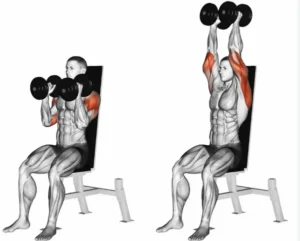
Supported lunge
- Place both your left and right feet about three feet apart.
- Secure your balance by holding onto a wall or chair.
- To make the front knee at a straight angle and the back knee a few inches off the ground, bring the knees down toward the floor and bend them.
- Avoid allowing your front knee to move forward and keep it behind your toes.
- To return to the beginning posture, raise through your front heel while maintaining a straight body and tightened abs.
- Then return to your neutral position
- Then relax.
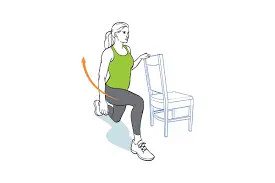
Biceps curl
- Stretch your feet shoulder-width apart.
- Take a dumbbell in each hand and stand upright.
- The dumbbells will come closer to your shoulders if you turn your arms to face forward and bend your elbows.
- Lift both dumbbells slowly.
- Hold this position for a few seconds.
- Keep your arms and body from shaking, as this takes away from your biceps.
- Then return to your neutral position
- Then relax.
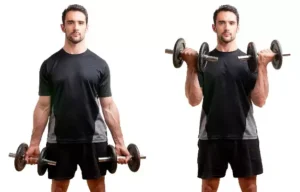
Jumping jacks
- Stand upright and hold your arms at your sides.
- Jump up now, keeping your legs shoulder-width apart.
- Also, raise your arms till they touch your head.
- To jump back to the starting position, bring your feet back together and lower your arms.
- As you continue, keep your speed constant and leap in and out in a steady motion.
- Then return to your neutral position
- Then relax.
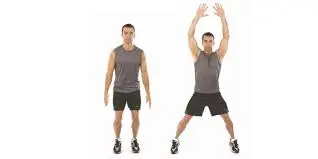
Lying Leg Raise
- Using your hands supporting your lower back and your legs straight, assume a comfortable supine position.
- As you tense your abdominal muscles and release your breath, bring your legs toward your forehead while maintaining a straight posture.
- Hold this position for a few seconds.
- Once your abs are fully squeezed and your legs are slightly above parallel, slowly return to the starting position.
- Then return to your neutral position
- Then relax.
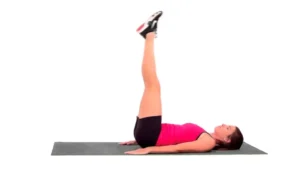
Burpees
- Keeping your back upright and your knees bent, begin by squatting.
- Your hands should be nearly within your feet when you lower them to the floor in front of you.
- Push your feet back to place yourself in a pushup position while maintaining your weight on your hands.
- You should complete one pushup with your body aligned from head to heels.
- Remind yourself not to stick your butt in the air or let your backdrop.
- Jump your feet back to their starting position.
- Lift your arms above your head and stand up.
- To get back to where you started, make a short jump into the air.
- Once your knees are bent, land again in a squat position.
- Then return to your neutral position
- Then relax.
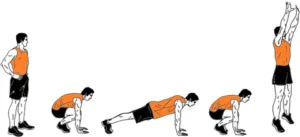
Crunches
- With your knees bent when you’re resting on the ground.
- Keep your hands folded over your chest or back to your head.
- Now squeeze your abdominal muscles.
- Use the muscles in your abdomen to squeeze your ribs toward your pelvis.
- Maintain a straight neck while you inhale and release air.
- Hold this position for a few seconds, breathing gently.
- Then return to your neutral position
- Then relax.
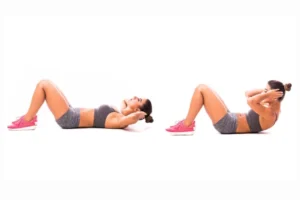
Mountain climber
- Start by getting onto your hands and knees on the floor.
- With your hands shoulder-distance apart, position your shoulders squarely above your wrists.
- The shoulders and the upper body can be correctly stabilized by spreading your fingers apart and pressing the gap between your thumb and index finger into the floor.
- Continuing the high plank posture with your right leg, try to maintain a straight body from heel to head.
- To do the plank position, move your left leg back until it meets your right leg.
- Be sure to maintain a neutral spine.
- Continue to feel as though your hands are pressing into the floor and that the area between your shoulder blades is being raised slightly toward the ceiling.
- Focus your attention on a location on the floor directly in front of your hands while maintaining your neck in alignment with your spine.
- Your right leg should be bent toward your chest using your abdominal muscles, then stepped back into the plank position.
- Once you have your left leg near your chest, step it back and repeat.
- Then relax.
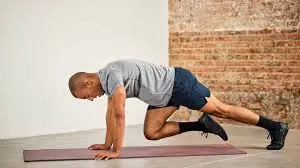
Plank
- While resting on the floor, place your forearms exactly under your shoulders.
- Raise your upper body slowly off the ground while applying pressure to your knees and forearms.
- Raise yourself while maintaining a neutral neck and spine by tightening your core.
- To make your body into a straight line, lift your knees and curl your toes beneath.
- Hold this pose for a few seconds.
- Then return to your neutral position
- Then relax.
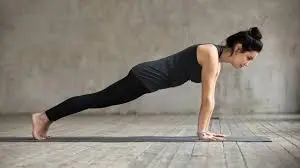
What precautions should be taken when working out?
- Starting as a beginner or at a level you believe you can reach and maintain is essential.
- Remember to warm up and cool down for five minutes after each workout to avoid pain and injury.
- If you have any pain when working out, stop right away and see a doctor if the pain doesn’t go away.
- Please speak with your physician before beginning a new fitness program or increasing your level of activity.
- Avoid using strong or forceful movements when working out.
- Remain hydrated by consuming enough water in advance of, during, and following your workout.
- When working out, take care to keep your posture correct.
- When you gain strength, slowly increase the number of sets and repetitions.
- To get the most out of your training, take deep, regular breaths.
- To avoid falling while exercising, maintain your focus and keep your eyes on yourself.
- Choose clothing that fits well and is loose enough to move freely for the best workout results.
- A small lunch should be eaten before exercising, and you should avoid eating right before or right after you go out if you’re hungry. It’s also not a good idea to wear clothing that is too tight or trendy.
- Being mindful of yourself and maintaining focus throughout exercise may help you avoid falls.
When are you going to stop exercising?
- Fever
- Blurry vision
- A headache
- Exercise should be stopped if it hurts.
FAQ:
Which type of exercise is most effective for beginning weight loss?
Running, swimming hard laps, doing a lot of gardening, and aerobic dance are examples of vigorous aerobic exercise. Weights or weight machines, as well as your body weight, can be used in strength training.
How can beginners reduce their weight?
Eat fewer calories than you need.
Don’t lose weight too quickly. Prioritize activities that raise your heart rate and result in significant burned calories.
Continue eating a lot of protein.
Which workout is easiest to begin with?
Squats.
Lunges.
Push-ups.
Pull-ups.
Planks.
Crunches.
How much exercise is necessary for weight loss?
Try to get in some exercise every day of the week. Aim for at least 300 minutes of moderate aerobic activity or 100 minutes of intense activity every week for even greater health advantages. This level of exercise may aid in weight loss or weight loss maintenance. However, even modest levels of exercise can be beneficial.
How might exercise help with weight control?
Your body utilizes more calories for energy when you’re more active. You lose weight when you create a calorie deficit by burning calories through activity and consuming fewer calories. Reducing caloric intake is the primary method of weight loss.
What if I’m unsure of how to perform these workouts properly?
You might want to speak with a trained fitness teacher or personal trainer. They may offer you advice on how to perform with the best form and technique to avoid injuries and get the best outcomes.
When does exercise start to show results?
Several variables, including your initial level of fitness, diet, and regularity, affect how long it takes to see results. Within a few weeks of consistent exercise, though, you might begin to observe improvements in your general well-being and energy levels.
References:
- M. F. M. A. Cpt. (2024, August 22). 10 beginner-friendly exercises. Very well-fitting. Easy weight-loss exercises for beginners (3495986) https://www.verywellfit.com
- On December 20, 2024, Kamb, S., and Kamb, S. Beginner’s Bodyweight Exercise (20-Minute at-Home Routine). Fitness for Nerds. Bodyweight exercise for beginners: burn fat, gain muscle, gain muscle Blog: https://www.nerdfitness.com/
- The top 7 weight-loss workouts for beginners. (August 11, 2015). health of men. https://www.menshealth.com/uk/workouts/g754647/7-best-weight-loss-exercises-for-beginners/
- R. Lockridge. March 8, 2024. 8-week Women’s Beginner Fat Loss Program. Strength and Muscle. The 8-week women’s beginner fat-loss workout can be found at https://www.muscleandstrength.com/workouts
- November 9, 2023; Rd, R. R. M. The Top 8 Workouts for Losing Weight. Health Line. Walking: https://www.healthline.com/nutrition/best-exercise-for-weight-loss
- On July 24, 2024, Hannah. Beginner’s 2-Week Workout Program for Losing Weight. The Weight Loss Clinic. Theslimmingclinic.com/blog/2-week-exercise-plan-for-beginners/
- Image 4, Running and strength training together can help you lose weight. https://thebridge.in/fitness-wellness/how-can-they-lead-to-weight-loss/#google_vignette
- Image 6, L. Putra, n.d. A man performs a wall push-up. Exercise for standing press-ups. A flat vector image set against a white background. character set for exercising. https://www.vecteezy.com/free-vector/wall-push-up Vecteezy
- Image 7, 2023a, December 6; DMoose. Mastering the Dumbbell Lateral Raise: A Beginner’s Guide. Shoulders: https://www.dmoose.com/blogs/dumbbell-lateral-raise
- Image 9, The image is located at https://www.facebook.com/photo.php?fbid=3749787135043757&id=464975210191649&set=a.489545607734609.
- Image 12, Be a strong woman. July 23, 2014. Leg Raises While Lying [Video]. YouTube. This is the video: https://www.youtube.com/watch?v=Wp4BlxcFTkE
